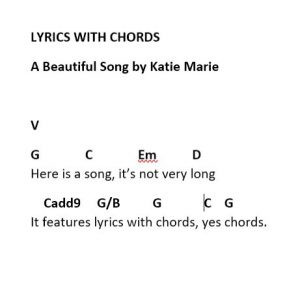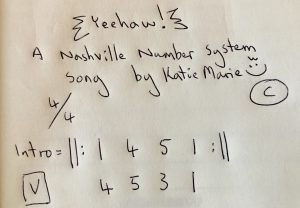Creating clear and effective Guitar Chords Charts, often referred to as lead sheets or simply song charts, is an essential skill for any musician, especially guitar players. Whether you’re heading into a recording studio, collaborating with other musicians, or just practicing at home, well-prepared guitar chords charts ensure everyone is on the same page, saving valuable time and fostering a smoother musical process. This guide will explore different types of guitar chords charts and how to create them effectively, focusing on clarity, accuracy, and practical application.
Understanding Song Structure: Your Chart’s Foundation
Before diving into different chart types, grasping basic song structure is crucial. Think of it as the roadmap for your song, guiding musicians through the different sections. Common abbreviations help keep charts concise and easy to read:
- Verse (V): The storytelling section of the song, often with varying lyrics but similar musical structure.
- Chorus (CH or C): The central, often most memorable part of the song, usually repeated with the same lyrics and melody.
- Bridge (B or BD/ M8 for “Middle 8” in UK): A contrasting section that provides a change of pace or perspective, often appearing later in the song.
- Instrumental (Inst): Sections where instruments take the lead without vocals, showcasing musicality.
- Outro (O): The ending section of the song, providing closure.
- Intro (Intro): The beginning section that sets the stage for the song.
- Pre-Chorus (Pre-CH): A transitional section that builds anticipation leading into the chorus.
Understanding these structural elements allows you to create a skeletal framework for your guitar chords chart, making it instantly understandable to other musicians.
Exploring Different Types of Guitar Chords Charts
Now, let’s examine various methods for charting your music, each with its own advantages depending on the context and your needs. While these are geared towards guitar and other melodic instruments, the principles can be adapted for percussion and drums as well.
1. Lyrics with Chords: Simplicity and Accessibility
 Lyrics with chords
Lyrics with chords
A simple guitar chords chart example displaying song lyrics with chord names placed above the words where the chord changes occur.
This is arguably the most beginner-friendly and widely used type of guitar chords chart. It’s straightforward: you write out the lyrics and place the chord names above the words where the chord changes occur.
Pros:
- Easy to Read: Very intuitive, especially for vocalists and guitarists who are less familiar with formal music notation.
- Quick to Create: Requires minimal music theory knowledge to get started.
- Focus on Song Flow: Keeps the lyrical content central, which can be helpful for performance and rehearsal.
Cons:
- Rhythmic Ambiguity: Doesn’t clearly indicate the rhythm or duration of chords within a measure, which can be problematic for complex rhythms or syncopation.
- Less Precise for Complex Music: Not ideal for intricate instrumental parts where precise timing and phrasing are critical.
Best For: Beginner guitarists, singer-songwriters, rehearsals, informal jam sessions, songs with relatively simple chord progressions and rhythms.
2. Standard Chord Charts: Adding Rhythmic Detail
 Chord Charts
Chord Charts
An example of a standard guitar chords chart in 4/4 time signature, showing chord names and rhythm markings to indicate chord durations within each bar.
Standard chord charts build upon lyrics-with-chords by incorporating rhythmic notation. This type of chart is particularly useful when rhythmic accuracy is important. Typically, the chart is structured in measures (bars) based on the song’s time signature.
Key Elements:
- Time Signature: Indicates the number of beats per measure (e.g., 4/4, 3/4, 6/8).
- Chord Names: Standard chord symbols (e.g., G, C, Am, D7).
- Rhythm Markings: Lines, dashes, or rhythmic notation below the chords to show how long each chord is played within a measure. For instance, in 4/4 time, four markings might represent quarter notes.
Pros:
- Rhythmic Clarity: Provides a much clearer picture of the song’s rhythm compared to lyrics-with-chords.
- Improved Communication: Reduces ambiguity for musicians regarding chord durations and placement within the bar.
- Versatile: Suitable for a wider range of musical styles and complexities.
Cons:
- Requires Basic Music Theory: Understanding of time signatures and basic rhythmic notation is needed.
- Slightly More Complex to Create: Takes a bit more effort than lyrics-with-chords charts.
Best For: Intermediate guitarists, band rehearsals, studio sessions, songs with more defined rhythmic patterns, communicating specific chord rhythms to band members.
3. The Nashville Number System: Flexibility and Key Changes
 Nashville Number System
Nashville Number System
A Nashville Number System chart example showing numbers representing chords within a key, allowing for easy transposition.
The Nashville Number System is a brilliant and efficient method, especially valuable in studio settings and live performance situations where on-the-fly key changes are needed. It uses numbers to represent chords within a key, rather than chord names.
How it Works (Major Key Example):
In a major key, each number corresponds to a scale degree and chord type:
- 1: Major chord (tonic)
- 2: Minor chord (supertonic)
- 3: Minor chord (mediant)
- 4: Major chord (subdominant)
- 5: Major chord (dominant)
- 6: Minor chord (submediant)
- 7: Diminished chord (leading tone)
Example in C Major:
- 1 = C Major
- 2 = D minor (Dm)
- 3 = E minor (Em)
- 4 = F Major
- 5 = G Major
- 6 = A minor (Am)
- 7 = B diminished (Bdim)
A chord progression in C major might be charted as: [ 1 1 4 5 ] [ 1 1 2 2 ]
This translates to: [ C C F G ] [ C C Dm Dm ]
Key Change Advantage: If you want to transpose to G major, the numbers remain the same. You simply apply them to the G major scale:
- 1 = G Major
- 2 = A minor (Am)
- 3 = B minor (Bm)
- 4 = C Major
- 5 = D Major
- 6 = E minor (Em)
- 7 = F# diminished (F#dim)
The same number chart [ 1 1 4 5 ] [ 1 1 2 2 ] in G major becomes: [ G G C D ] [ G G Am Am ]
Rhythm and Notation: The Nashville system also employs symbols for rhythm. A diamond around a number often indicates a sustained chord, while a “^” above a number might mean a staccato or cut-off chord. However, many users adapt standard rhythmic notation for clarity.
Pros:
- Key Transposition: Effortlessly change keys without rewriting the entire chart.
- Streamlined Charts: Numbers are concise and quick to write.
- Industry Standard: Widely used in professional music circles, particularly in Nashville and country music.
Cons:
- Requires Key Knowledge: Musicians need to understand key signatures and scale degrees.
- Less Intuitive Initially: Takes some learning to become comfortable with number-based notation.
Best For: Professional musicians, studio sessions, rehearsals where key changes are possible, songwriters who experiment with different keys, situations where charts need to be flexible and adaptable.
4. Full Music Score: Complete Detail and Precision
A sample of a full music score, displaying detailed notation including melody lines, rhythms, harmonies, and potentially instrumentation.
A full score is the most comprehensive and detailed method of charting music. It uses traditional music notation to represent every aspect of the song, including melody, harmony, rhythm, dynamics, and sometimes even instrumentation.
Pros:
- Maximum Detail: Captures every nuance of the music, leaving no room for ambiguity.
- Universal Language (Music Notation): Standard music notation is understood by classically trained musicians worldwide.
- Best for Complex Arrangements: Ideal for intricate compositions, orchestral pieces, or music where precise notation is critical.
Cons:
- Steep Learning Curve: Requires extensive knowledge of music theory and notation reading.
- Time-Consuming to Create: Writing full scores is a lengthy and meticulous process.
- Not Always Necessary: Often overkill for simpler songs or genres where less formal charts suffice.
- Reader Skill Dependent: Many contemporary musicians, especially outside classical genres, may not be proficient in reading full scores.
Best For: Classical musicians, orchestral arrangements, film scoring, highly complex compositions, situations where extreme precision and detail are paramount, communicating with musicians who are fluent in music notation.
Tips for Creating Effective Guitar Chords Charts
Regardless of the type of chart you choose, these best practices will ensure clarity and usability:
- Accuracy is Paramount: Double-check your chord names, rhythms, and song structure. Mistakes in charts can lead to confusion and wasted time.
- Keep it Clean and Legible: Use clear handwriting or well-spaced digital fonts. Avoid clutter and unnecessary details.
- Use Standard Abbreviations: Employ common abbreviations for song sections and chord types (maj, min, 7, etc.).
- Highlight Key Sections: Use bolding, underlining, or boxes to emphasize important parts like choruses or bridges.
- Practice with Your Charts: Before a session or rehearsal, play through the song using your chart to ensure it flows logically and accurately represents the music.
- Consider Your Audience: Choose a chart type that is appropriate for the musicians you are working with and their level of music reading proficiency.
- Page Numbering and Song Title: Include page numbers if your chart is multiple pages and always clearly label the song title.
Final Thoughts
Creating effective guitar chords charts is a vital skill that enhances communication, efficiency, and musicality in both practice and professional settings. By understanding the different types of charts available and applying best practices, you can create clear, accurate, and helpful guides that empower yourself and other musicians to bring your musical ideas to life. Whether you opt for the simplicity of lyrics-with-chords or the detail of a full score, the goal is always to facilitate a smoother and more productive musical experience.

